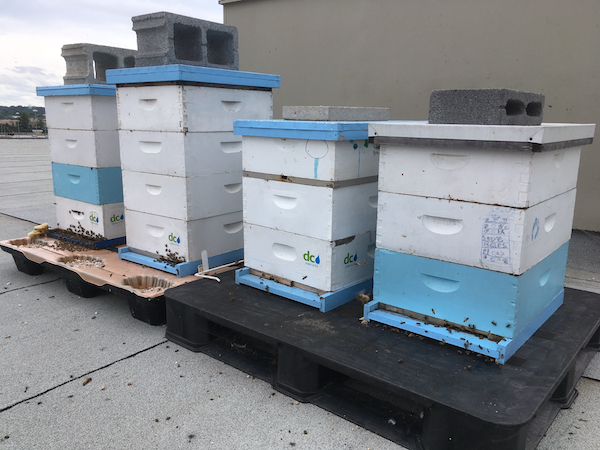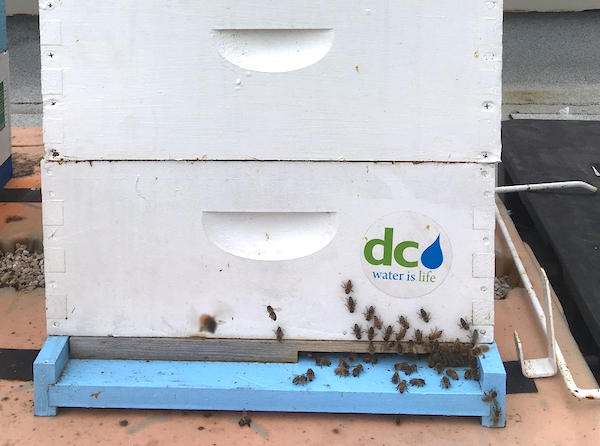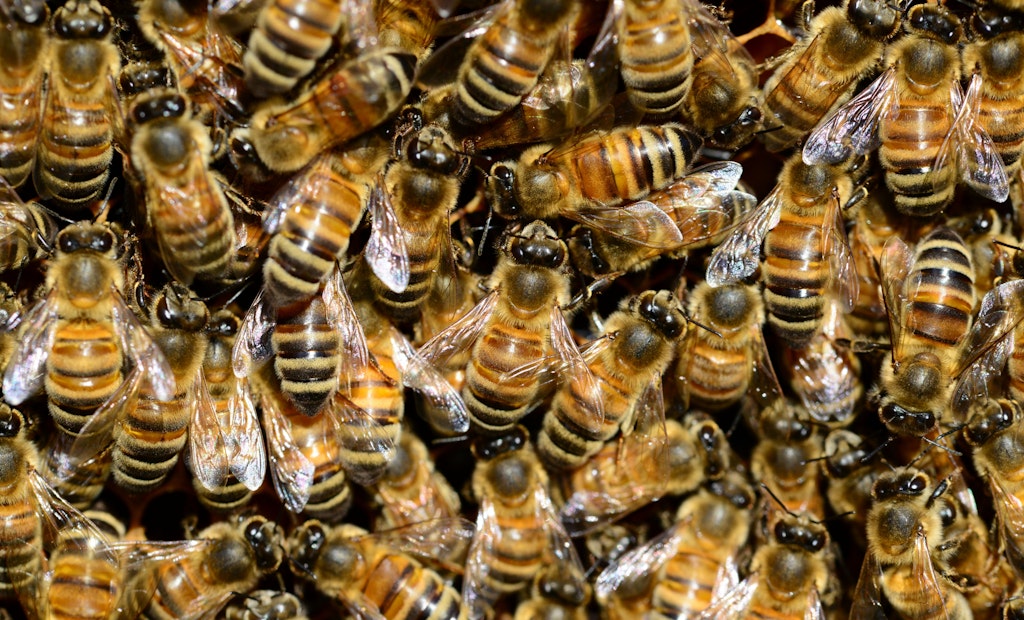You’d have to look closely to notice the activity atop the utility building, but an otherwise plain rooftop has been transformed into a miniature ecosystem.
The District of Columbia Water and Sewer Authority (DC Water) has partnered with the D.C. Beekeepers Alliance to provide a healthy home for honeybees. Currently, the utility has four hives on the roof of the Central Maintenance Facility at the Blue Plains Advanced Wastewater Treatment Plant. Officials hope the effort provides environmental benefits and might serve as a model to other water facilities across the country.
“The organization wants to be a good environmental steward,” says Bill Brower, manager of resource recovery for DC Water. “We want our program to be part of the urban agriculture movement, and beekeeping is part of that.”
Brower and DC Water co-worker Chris Peot conceived the idea about three years ago. Brower says they have a mutual interest in learning about beekeeping, and are aware of recent nationwide declines in honeybee populations. They reached out to several people, including Toni Burnham, president of the D.C. Beekeepers Alliance, who was excited about the idea.
From there, DC Water worked with Burnham to host some of her hives at the facility. The utility purchased bees and much of the equipment, while Burnham provided the required woodenware and much of the beekeeping knowledge and experience. For three seasons, they’ve worked cooperatively to manage the hives.
“It’s a good way to do it, as having bees is not a minor undertaking,” Brower says. “You really have to carefully watch them, and then it takes a lot of expertise to keep them going and thriving. That’s what has worked well with us, having a partner system. Toni is an excellent beekeeper, so it definitely falls upon her for a lot of the expertise.”

This is a view on the rooftop of the Blue Plains treatment facility showing the four honeybee hives DC Water is hosting. —Photo Courtesy of DC Water
Burnham says the Blue Plains facility hives range in strength from intermediate to super-strong. Brower says they’ve had no issues with the bees interacting negatively with people, as most of the insects travel and feed well above ground level. Everyone agrees that the program has gone well, but it hasn’t been without unique challenges.
“Blue Plains is the largest industrial site in D.C., and figuring out how to keep bees well there would be a sign of great hope and potential for urban beekeeping across the country,” Burnham says. “It is, however, not the same as typical apiaries, and we’ve had a lot to learn, mostly about prevailing winds and the energy costs to each individual bee of finding and bringing back forage. This year, we think we are learning more about challenges to colonies that re-queen themselves, and we may need to change up our game around that.”
Another challenge occurred earlier this year, when a hive “threw a swarm,” which occurs when the queen bee leaves the colony with many of the worker bees to form a new colony. Brower, Burnham and another DC Water employee collected the swarm of bees without incident, and Burnham then put them in a new apiary.
“What surprised us was that it was a different hive than one we’d been working on to suppress swarming,” Burnham says. “Swarms happen when bee colonies are so strong that one decides that it could split and become two.”
Burnham says the Blue Plains facility — the world’s largest advanced wastewater treatment plant, with the design capacity to process about 370 million gallons of water per day — has proven to be a good site for the apiary.

Here's a close-up view of one of the honeybee hives. — Photo Courtesy of DC Water
“Bees need good access to water, which was a no-brainer, and the Blue Plains site is also directly on the Potomac River with a wooded ridge on the other side,” she says. Further, the facility is near Oxon Hill Farm, a national historic district that has a living farm museum.
In fact, Brower says many wastewater treatment facilities nationwide would probably be good sites for apiaries because of their proximity to water and pollinating plants, and because they cover large areas and aren’t located in densely populated neighborhoods.
“That’s the part that could be replicable elsewhere in this marriage between keeping bees in urban areas,” he says.
Public outreach and education are also critical elements of the program, Brower says. In late May, he, Peot and Burnham conducted a honey-harvesting demonstration at an area grade school using some hive frames from Blue Point. Students scraped the combs to release honey, and then the combs were spun in a large vat so the honey could be collected. Also, some honey collected at other times from Blue Point hives was bottled and given to public officials.
With such a tasty byproduct and the positive environmental impact provided by the apiary, some folks would like to expand the program. Brower says other DC Water properties — including a new headquarters building currently under construction — might be good sites for apiaries. The problem is finding another beekeeper interested in hosting the hives.
It also wouldn’t surprise anyone if other wastewater utilities expressed interest in similar programs. Brower says DC Water has discussed the topic informally with one other utility and believes the idea will gain more attention.
“I think word is just kind of getting out,” he says. “I think that even if it’s just kind of a hosting relationship, it's kind of a nice community outreach thing.”
Burnham agrees that the cooperative management approach and resulting benefits are ideal.
“One of our goals as city beekeepers is to weave ourselves into the DNA of our communities in much the same way that bees do in the green world,” she says. “We want to be ordinary and for the role of beekeeping to be understood. There is nothing more basic and more ubiquitous to life than water, so what better partner? Also — and this is not hype — DC Water has proven itself high quality, innovative and green over and over again. We could trust them, and they could trust us. We both know that the highly populated future is going to provide us both with challenges essential to protecting the living world around us — people included.”
And if two seemingly dissimilar disciplines can come together for a common goal, everyone benefits.






